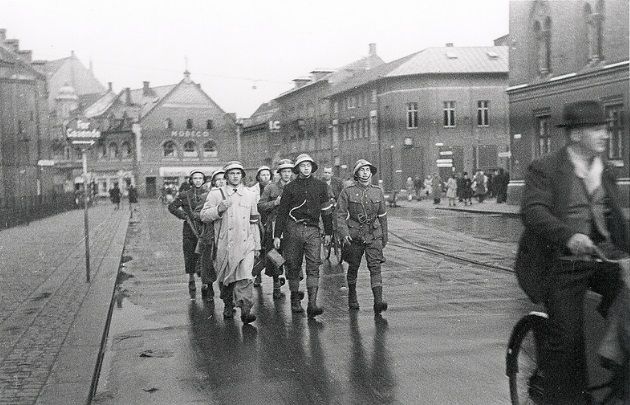Despite the presence of plaques and statues scattered throughout Copenhagen, very few people realise the role the Danish Resistance played in fighting the Nazis during the Second World War.
While nearly every Dane is aware of the Occupation, few realise the lengths taken by a defiant minority to express their dissatisfaction with their Nazi overlords and contribute to the Allied war effort.
The date was 10 April 1940, and Danes in Copenhagen woke to the sound of stukas and other German warplanes circling the capital.
As Operation Weserubung continued, armoured vehicles drove slowly through the streets and columns of German infantry marched triumphantly up to Rådhuspladsen, their Nazi flag held high in front of them.
While the knowing few wept openly, most were confused by the sudden change in the city.
A quiet takeover
There was no fighting, no loud explosions, no burning buildings, and most listened in bemusement as a German officer explained via his megaphone the need for his German soldiers to “protect” the city.
After spectacular success in Poland and France, Hitler moved his Werchmact north in order to safeguard both Denmark and Norway from British influence.
The Germans were there in order to thwart British ‘aggression’ following the mining of sea lanes between England and Denmark.
The Danes were close to Hitler’s (mythical) perfect race, and due to his desire to model Denmark as an example of an agreeable Protectorate, they enjoyed unusually generous conditions of occupation compared with countries like Norway or France.
The Danish government was allowed to remain, the police remained under the government’s control, and the Jewish question was not initially considered.
This situation was further complicated by the fact that Denmark had not officially declared war on Germany.
Despite the clear occupation of the country, Germany had insisted that Denmark remain ‘independent’ and did not consider itself an occupying power.
Although not in support of the Nazis, the Danish government nevertheless agreed to the terms set out by them and advised their military and citizens to avoid armed resistance.
Although most agreed, some did not and almost immediately resistance materialised.
Fearing that their ships would be appropriated, many in the Danish navy sailed to Allied ports and some ambassadors in Europe refused to accept their government’s line.
A ride with the king
Communications were set up between members of the Danish military intelligence and their British counterparts, and some journalists became informers in both Denmark and neutral Sweden.
Although widely published, King Christian’s daily ride on his horse through the capital was largely symbolic – a relatively passive way of attempting to reassure his people, many of whom followed him on their bikes.
A statue of the king on top of his horse can be seen today on Sankt Annæ Plads leading to Amalienborg Palace.
It was in the actions of ordinary Danes, however, that active resistance came about. The Churchill Club was one of the first resistance groups to arise.
Made up of schoolboys under the leadership of 17-year-old Knud Pederson, the group was responsible for 25 acts of sabotage on German targets and continued to operate despite many members being imprisoned.
Another larger and better equipped group was Holger Danske, named after the famous Danish hero.
Tension beneath the surface
Formed by five members of the military who had fought on the side of the Finns in the Winter War, Holder Danske was unprepared to accept its government’ acquiescence to the Nazis and was disdainful of what it saw as the population’s widespread co-operation.
Engaging in both sabotage and counter-intelligence, the group was responsible for the destruction of the Forum Arena in 1943.
BorgeligePartisaner (also known as Bourgeois Partisans or BOPA) was a similar group.
Comprised of communist sympathisers, members of the Danish army and schoolboys, BOPA began to engage in acts of sabotage throughout 1942, gaining momentum in the second half of the occupation.
The group was responsible for attacks on German shipping interests, attacking supply ships and docking facilities.
Fleets of freedom
By 1943 it had become clear that the Nazis could not win the war and the membership of the Danish resistance groups grew exponentially.
Through contact with the British Special Operations Executive, the resistance groups were able to receive better supplies via airdrops and soon began to expand their operations.
In September of that year the ‘Danish Freedom Council’ was established in an attempt to unify the resistance groups, and the attacks on German interests increased.
The Nazis’ attempt to impose martial law on the country was largely ineffective,and SS General Werner Best decided to target Denmark’s Jewish population in a lame attempt at saving face.
There followed perhaps the greatest resistance to Nazi ambitions, with whole swathes of the Danish population involved in shepherding more than 7,000 Danish Jews to freedom in neutral Sweden.
Following the D-Day landings of 1944, the Danish resistance targeted railway lines, attempting to prevent the resupply of German troops moving from Norway to France.
Under-appreciated Danes
By the end of the war, it is estimated that close to 30,000 Danes had participated in the various resistance movements, with more than 850 killed and countless more tortured and imprisoned.
Although overshadowed by larger resistance networks in countries like France, the contribution of the Danish resistance to the overall war effort is something that can make Danes feel proud.
Next time you spy a bronze plaque embedded in a wall or pavement throughout the city, it’s worth spending a moment or two reading it.











